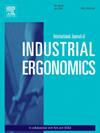Comfort perception on wheelchair lock actuating rod position in younger and older adults
IF 2.5
2区 工程技术
Q2 ENGINEERING, INDUSTRIAL
International Journal of Industrial Ergonomics
Pub Date : 2025-03-18
DOI:10.1016/j.ergon.2025.103731
引用次数: 0
Abstract
The operability and comfort of the wheelchair lock actuating rod (WLAR) are paramount in ensuring users' operational safety. This study aims to evaluate the impact of the WLAR in different position configurations on users' comfort perception and to explore the effects of human factors such as age, gender, and height on comfort perception scores. A total of 40 participants were invited to participate in the study, comprising 20 younger adults (10 men and 10 women, aged 20–30) and 20 older adults (10 men and 10 women, aged 50–90 years). In the experiment, the position of the wheelchair lock was randomly adjusted, and then the participants operated the actuator and provided a comfort perception evaluation. Subsequently, the data were subjected to statistical analysis using ANOVA, and the results demonstrated that age and height significantly influenced the comfort scores, while gender did not exhibit a statistically significant impact. In particular, men exhibited higher Kansei scores for "postural comfort" than women, whereas women demonstrated higher scores for other comfort evaluations than men. For the older participants, the K8 position was determined to be the optimal position for the WLAR. These findings indicate that age, gender, and height are significant variables influencing the perceived comfort of the WLAR position, underscoring the necessity of incorporating individual differences in the design of the WLAR. The findings of this study can inform the design and optimal positioning of the WLAR for older users, enhancing its operability and comfort.
求助全文
约1分钟内获得全文
求助全文
来源期刊
CiteScore
6.40
自引率
12.90%
发文量
110
审稿时长
56 days
期刊介绍:
The journal publishes original contributions that add to our understanding of the role of humans in today systems and the interactions thereof with various system components. The journal typically covers the following areas: industrial and occupational ergonomics, design of systems, tools and equipment, human performance measurement and modeling, human productivity, humans in technologically complex systems, and safety. The focus of the articles includes basic theoretical advances, applications, case studies, new methodologies and procedures; and empirical studies.

 求助内容:
求助内容: 应助结果提醒方式:
应助结果提醒方式:


